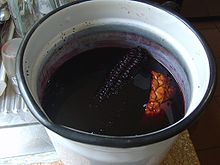Chicha morada
Chicha morada is a typical non-alcoholic drink from Peru . It is made on the basis of purple corn (also called purple corn), which is popularly known as maíz morado .
Origin and Distribution
Purple maize is a variety of ordinary maize that has a strong dark purple color on the whole ears as a special feature. The color comes from the high proportion of anthocyanins . The purple maize grows mainly in the Andes , as it requires special climatic conditions in order to fully develop the characteristic purple color. The corn cobs dry on the plant and are then freed from the fish leaves and brought to market.
Even before the Inca period, the indigenous people of Peru used the purple maize, as shown by grave finds and clay objects. The current form of preparation is a result of the culinary mix of styles that arose in Peru with the arrival of the Spaniards and African slaves.
The drink is ubiquitous in Peru, especially in the capital Lima . The non-alcoholic version of Chicha is also popular with children and is an integral part of every social event in competition with soft drinks.
The Bolivian variant is called Api , is served hot, flavored with cloves and is a little thicker. Api is popular all over the country except in the (sub) tropical areas and is usually taken in the afternoon together with deep-fried flatbreads ( sopaipilla ) or similar.
preparation
Traditionally, the purple corn is washed whole and then boiled in water along with pineapple and quince peels, cinnamon and cloves until the corn kernels have softened and the liquid has turned its dark purple color. The liquid is sieved, seasoned with sugar and lemon juice and served cold. It is common to serve it with chopped apples.
A traditionally prepared chicha morada can be clearly differentiated in terms of taste from synthetic beverage preparations , which are also presented on the market as “chicha morada”, but contain synthetic flavors together with food colorings as the flavor-bearing ingredient. On the other hand, chicha morada made from purple corn are available in bottles (with a high proportion of granulated sugar and, if necessary, preservatives and flavorings) and in filter bags (free of sugar, preservatives and flavorings). The latter have to be boiled, but in contrast to traditional preparation, they only need a few minutes instead of almost an hour to cook and offer more flexibility in the form of preparation.
Attributed properties
When served cold, the chicha morada is known and valued as a highly effective refreshment.
An antihypertensive effect is popularly attributed to the chicha morada , although it has not yet been clearly proven in clinical studies.
The subject of research, however, is the high proportion of antioxidants. Researchers at Nagoya University in Japan found positive effects on rats in inhibiting the development of rectal cancer and in protecting the liver from antioxidants. Researchers at Ohio State University experimented with human cancer cells cultures by adding different anthocyanins . This makes the anthocyanins of purple maize the most powerful of all the substances investigated, not only when it comes to inhibiting the growth of cancer cells, but even when they are destroyed.
Individual evidence
- ^ Cancer Letters . 171, Issue 1, 2001
- ^ Archives of Biochemistry and Biophysics , Volume 368, Issue 2, 1999
- ^ Annual Meeting of the American Chemical Society , Boston (Mass.), August 2007
Web links
- Information from the Peruvian Institute for Agricultural Research (INIA) (pdf, Spanish; 194 kB)
- Article in the Peruvian weekly Caretas about the research at Nagoya University
